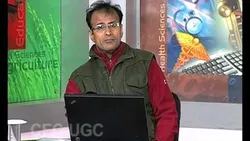
Film Appreciation 
This course provides an overview of Hindi cinema and its themes of social reform, globalization, censorship, and the portrayal of women. It also covers the history of Indian cinema, from the Partition of India to the films of V. Shantaram, Prakash Jha, K. A Abbas, Mehboob Khan, Raj Kapoor, Yash Chopra, Hrishikesh Mukherjee, Gulzar, Mahesh Bhatt, and more. Students will gain an understanding of the movements in cinema and the socio-cultural and economic perspectives. ▼
ADVERTISEMENT
Course Feature
![]() Cost:
Cost:
Free
![]() Provider:
Provider:
Youtube
![]() Certificate:
Certificate:
Paid Certification
![]() Language:
Language:
English
![]() Start Date:
Start Date:
On-Demand
Course Overview
❗The content presented here is sourced directly from Youtube platform. For comprehensive course details, including enrollment information, simply click on the 'Go to class' link on our website.
Updated in [February 21st, 2023]
What does this course tell?
(Please note that the following overview content is from the original platform)
Hindi Cinema and the theme of social reform - Part 2.
Hindi cinema and the theme of social reform.
Hindi Cinema and Globalization.
Hindi Cinema and Globalization - Part 2.
Cinema and Censorship : A Historical Perspective.
Cinema and Censorship : A Historical Perspective - Part 2.
Cinema and Censorship : A Historical Perspective - Pat 2.
Potrayal of Women in Hindi Cinema.
Potrayal of Women in Hindi Cinema - Part 2.
Hindi Parallel Cinema.
Hindi Parallel Cinema - Part 2.
Neo-Realism in Indian Cinema - Part 2.
Neorealism in Indian Cinema.
Neorealism in Indian Cinema - Part 4.
100 Years of Indian Cinema.
100 Years of Indian Cinema -II.
100 Years of Indian Cinema -III.
100 Years of Indian Cinema - IV.
Indian Cinema and the Partition of India.
Indian Cinema and the Partition of India - III.
Indian Cinema and the Partition of India - II.
Socio-culture Perspective in Indian Cinema.
Films of V. Shantaram.
Films of Prakash Jha.
Socio-economic and Cultural Perspective : Films of K. A Abbas films.
Films of Mehboob Khan.
Films of Raj Kapoor.
Films of Yash Chopra.
Films of Hrishikesh Mukherjee.
Films of Gulzar.
Films of Mahesh Bhatt.
Movements in Cinema : An Introduction.
Hindi Cinema Down the Ages : An Introduction.
We consider the value of this course from multiple aspects, and finally summarize it for you from three aspects: personal skills, career development, and further study:
(Kindly be aware that our content is optimized by AI tools while also undergoing moderation carefully from our editorial staff.)
1. Historical Perspective: Through this course, learners can gain a comprehensive understanding of the history of Hindi cinema, from its beginnings to the present day. They can explore the various movements in cinema, such as neorealism, parallel cinema, and the Partition of India, and gain insight into the socio-cultural and economic perspectives of the films of various directors, such as V. Shantaram, Prakash Jha, K. A Abbas, Mehboob Khan, Raj Kapoor, Yash Chopra, Hrishikesh Mukherjee, Gulzar, and Mahesh Bhatt.
2. Social Reform: Learners can gain an understanding of the theme of social reform in Hindi cinema, and how it has been used to address various issues in Indian society. They can explore the various ways in which filmmakers have used the medium to address issues such as gender inequality, poverty, and caste discrimination. They can also gain insight into the impact of globalization on Hindi cinema, and how it has shaped the industry.
3. Censorship: Learners can gain an understanding of the history of censorship in Hindi cinema, and how it has been used to control the content of films. They can explore the various ways in which filmmakers have used the medium to challenge censorship, and gain insight into the impact of censorship on the industry.
4. Appreciation: Learners can gain an appreciation for the art of filmmaking, and the various techniques used by filmmakers to create compelling stories. They can explore the various genres of Hindi cinema, and gain insight into the various themes and motifs used by filmmakers to create powerful films. They can also gain an understanding of the various techniques used by filmmakers to create visually stunning films.
5. Globalization: Learners can gain an understanding of the impact of globalization on Hindi cinema, and how it has shaped the industry. They can explore the various ways in which filmmakers have used the medium to address global issues, and gain insight into the various ways in which Hindi cinema has been influenced by global trends. They can also gain an understanding of the various ways in which Hindi cinema has been used to promote Indian culture and values.
[Applications]
After completing this course, students should be able to apply their knowledge of Hindi cinema and the theme of social reform to their own lives. They should be able to analyze films from a socio-cultural perspective and understand the impact of censorship on Indian cinema. They should also be able to recognize the influence of globalization on Hindi cinema and the impact of the Partition of India on Indian cinema. Furthermore, they should be able to appreciate the works of renowned filmmakers such as V. Shantaram, Prakash Jha, K. A Abbas, Mehboob Khan, Raj Kapoor, Yash Chopra, Hrishikesh Mukherjee, Gulzar, Mahesh Bhatt, and understand the various movements in cinema.
[Career Paths]
1. Film Critic: Film critics review films and provide commentary on them. They analyze the film's plot, characters, themes, and other elements to provide an informed opinion. They also provide insight into the film's cultural and historical context. Developing trends in this field include the use of social media to reach a wider audience and the use of video reviews to provide more detailed analysis.
2. Film Director: Film directors are responsible for the creative vision of a film. They work with the cast and crew to bring the script to life and ensure that the film meets the desired artistic and technical standards. Developing trends in this field include the use of digital technology to create more visually stunning films and the use of virtual reality to create immersive experiences.
3. Film Editor: Film editors are responsible for assembling the footage into a cohesive narrative. They work with the director to ensure that the film is edited in a way that best conveys the story. Developing trends in this field include the use of non-linear editing software to create more complex and dynamic films and the use of motion graphics to add visual effects.
4. Film Producer: Film producers are responsible for overseeing the production of a film. They work with the director to ensure that the film is completed on time and within budget. Developing trends in this field include the use of crowdfunding to finance films and the use of digital distribution platforms to reach a wider audience.
Course Provider

Provider Youtube's Stats at AZClass
Over 100+ Best Educational YouTube Channels in 2023.
Best educational YouTube channels for college students, including Crash Course, Khan Academy, etc.
AZ Class hope that this free Youtube course can help your Film & Theatre skills no matter in career or in further education. Even if you are only slightly interested, you can take Film Appreciation course with confidence!
Discussion and Reviews
0.0 (Based on 0 reviews)
Explore Similar Online Courses

Input Sensors with PLC: Sinking and Sourcing

Beginning Soldering for Jewelry Making

Python for Informatics: Exploring Information

Social Network Analysis

Introduction to Systematic Review and Meta-Analysis

The Analytics Edge

DCO042 - Python For Informatics

Causal Diagrams: Draw Your Assumptions Before Your Conclusions

Whole genome sequencing of bacterial genomes - tools and applications

James Cameron Teaches Filmmaking

Make A Short Film Documentary


Start your review of Film Appreciation